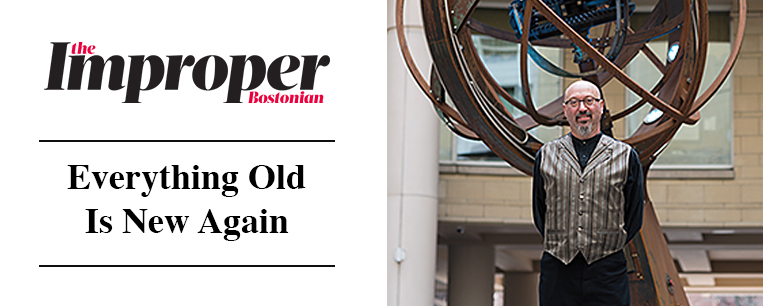

Everything Old Is New Again
By Scott Kearnan | Photo By Holly Rike | April 21, 2017
Bruce Rosenbaum of ModVic

“Resilience” is an important word to Bruce Rosenbaum. It saw him through the early loss of his father and his own battle with Hodgkin lymphoma. And it aided him through dire financial straits when he and his wife, Melanie, sunk more than a million dollars into restoring and modernizing a 20-room, 1877-built Victorian Italianate home in North Attleboro—right before the market crashed, forcing them to return it to the bank unsold.
It’s also the word that draws Rosenbaum, an artist, designer and entrepreneur, to his signature aesthetic: steampunk, a funky, science fiction-inspired marriage of 19th-century machinery and modern technology. Recall the stylish gizmos imagined by authors Jules Verne and H.G. Wells or depicted in The Wild Wild West, one of Rosenbaum’s favorite TV series as a child.
“Steampunk is all about resilience,” Rosenbaum says. “You look at objects the way you might look at a situation, saying, ‘Time has passed us by, so we need to adapt, change and evolve in order to thrive and survive.’ It’s about being a creative problem solver.”
In 2007, he and his wife founded the design firm ModVic. Their clients commission functional designs that make innovative use of their arsenal of antiques—most procured through fairs and online auctions—and steampunk sensibility. For Wooster Street Social Club, the tattoo parlor setting of TLC’s reality show NY Ink, the Rosenbaums repurposed a 1907 industrial gas pump as a tattooing station, retrofitting it with a camera and a flat-screen monitor so customers could watch the tattoo artist work on their back. Behind the front desk at the Nantucket Hotel + Resort, gears inside a ModVic-made 6-foot-long metal whale flap a wooden tail while a security camera in the blowhole keeps watch over the lobby. And at Hotel Marlowe in Cambridge, guests are greeted outside by a 25-foot tall, 6,000-pound steel, copper and bronze armillary—an old-fashioned astronomical tool—made from 100-year-old mill gears and high-tech, color-shifting LED lights with help from frequent collaborator Salmon Studios, a metal fabricator in Western Mass.
“Something goes on in my brain when I come up with projects that integrate art and technology,” Rosenbaum says. He likes to wax cerebral about steampunk, citing neuroscience research about increased dopamine levels in brains exposed to art that combines familiar forms with unexpected novelties. “I go on these quests to find relevant objects that will touch people on an emotional level.”
His work has brought him national renown in steampunk circles. Ironically, he had never even heard the word until friends ascribed it to his home, a 1901 Victorian Craftsman in Sharon. Among the fantastical wonders inside: an antique pump organ repurposed as a computer workstation, a copper water heater that now dispenses filtered H2O into doggie bowls, a fireplace mantel and insert reimagined as framing for a home theater system—and lots of whirring doodads, doohickeys and thingamajigs.
Now Rosenbaum, who will appear at Waltham’s annual Watch City Steampunk Festival on May 13, is undertaking one of his biggest projects yet. He and his wife recently sold their Sharon home to purchase a 9,000-square-foot, 1876-built Gothic church in Palmer, with plans to convert it into a living, working and gallery space they hope will turn the old mill town into “the capital for steampunk in America.” Full steam ahead.
